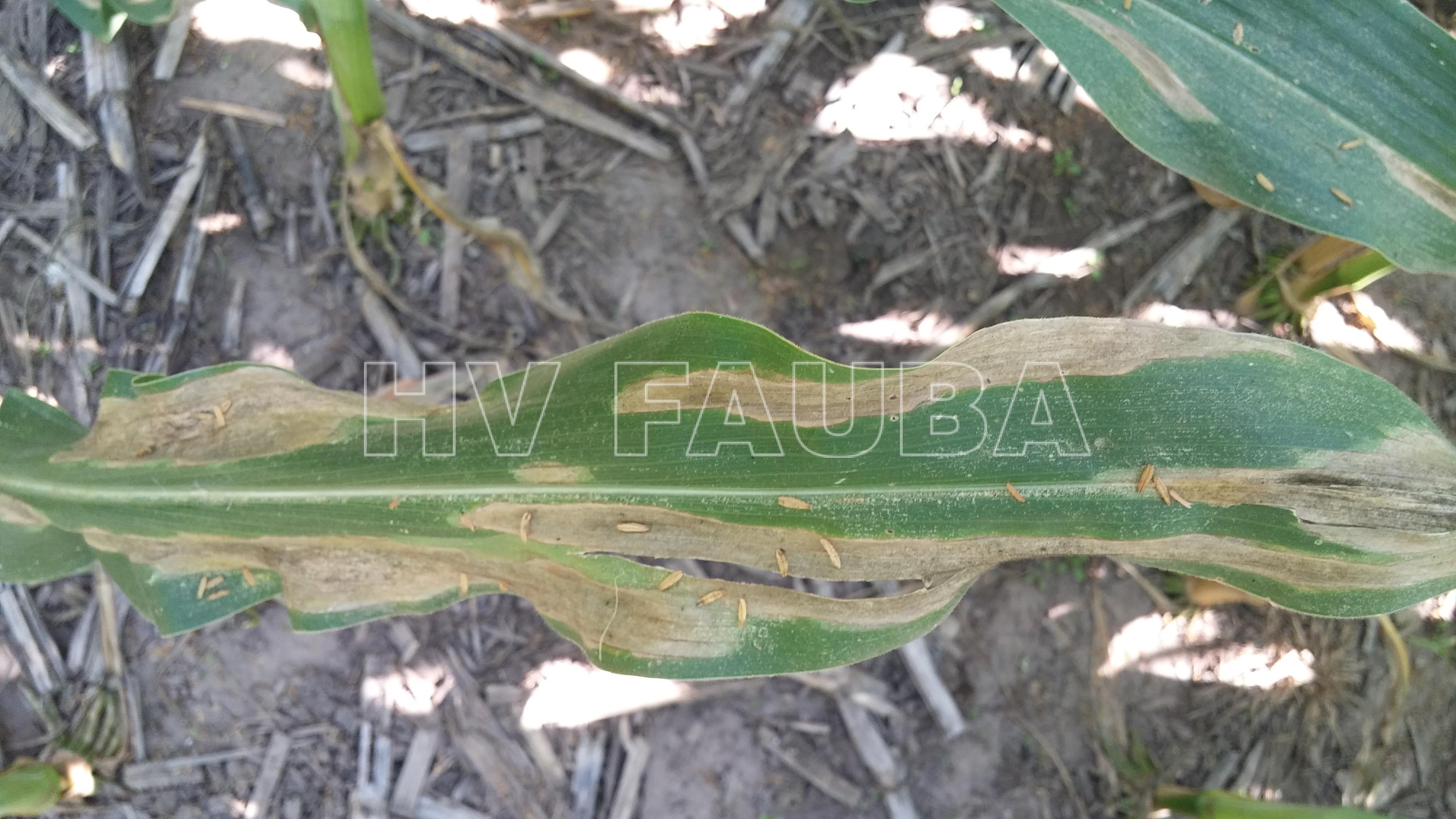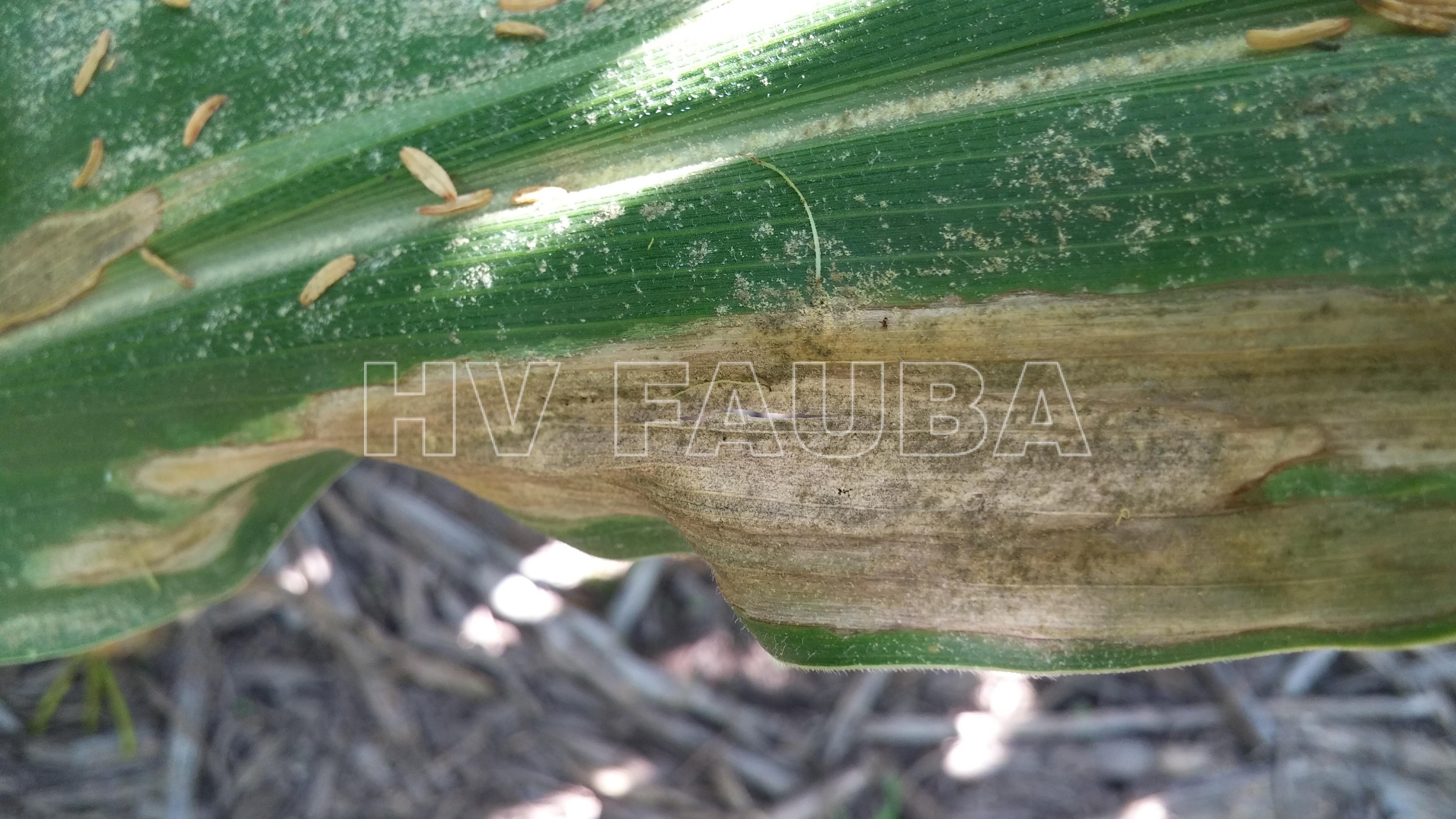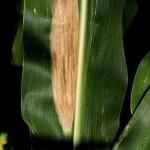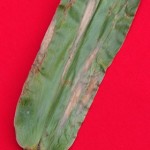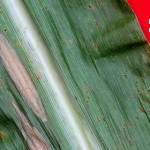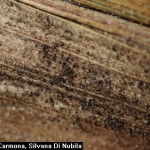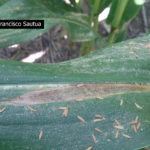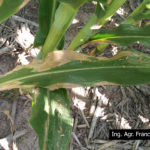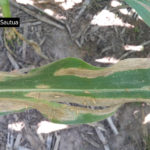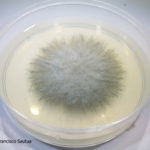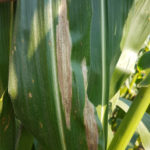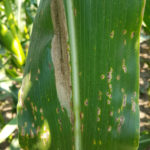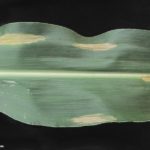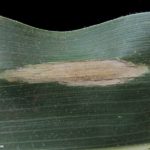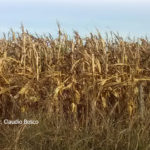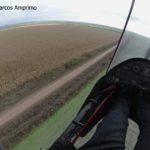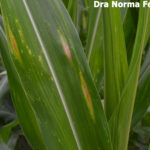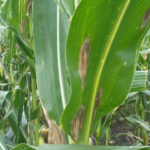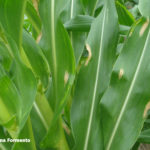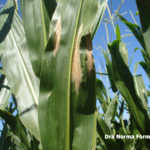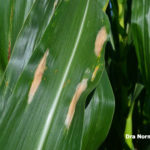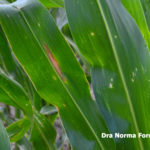.
Condición fitosanitaria: Presente ampliamente distribuida
Grupo de cultivos: Cereales
Especie hospedante: Maíz (Zea mays)
Rango de hospedantes: Shurleff (1980), Frederiksen y Franklin (1980) y Wathaneeyawech et al. (2015) estudiaron el rango de hospedadores de E. turcicum y encontró que además de maíz, el sorgo, cebada, avena, arroz, mijo, pasto de Sudán, pasto Johnson y plántulas de tabaco son hospedantes alternativos de este patógeno. Sin embargo, el único hospedante epidemiológicamente importante es el sorgo.
Etiología: Hongo. Hemibiotrófico
Agente causal: Exserohilum turcicum (Pass.) K.J. Leonard & Suggs, 2018
Taxonomía: Eukaryota > Fungi > Dikarya > Ascomycota > Pezizomycotina > Dothideomycetes > Pleosporales > Pleosporaceae > Exserohilum (anamorph)
synonym: Helminthosporium turcicum
.
La enfermedad fue descripta por primera vez en 1876 por Passerini (Campi, 1938).
Actualmente, en Argentina y Brasil predomina la raza 0 (cero) (Navarro et al., 2021).
.
.
- Conidios de Exserohilum turcicum. Autor: Marcelo Carmona, Francisco Sautua
- Conidio de Exserohilum turcicum. Autor: Marcelo Carmona, Francisco Sautua
.
.
Antecedentes
Durante la campaña 2009-2010, esta enfermedad atacó severamente a lotes de maíz especialmente en la zona maicera de Córdoba y en algunas de Santa Fe. Desde entonces su importancia se ha incrementado especialmente sobre maíces de siembra tardía. El control químico y genético son alternativas para su manejo emergencial.
.
Síntomas
Uno de los primeros síntomas consiste en la aparición de manchas pequeñas, ligeramente ovaladas y acuosas que se producen en las hojas. Estas lesiones se transforman luego en zonas necróticas y alargadas. Los síntomas aparecen generalmente en las hojas inferiores aproximadamente una semana después de la infección, como lesiones foliares de forma elíptica y alargadas. La longitud puede variar de 2,5 a 15 cm, y son predominantemente de color ceniza, a veces verde-grisáceas o pardas. La expresión de los síntomas puede variar dependiendo del genotipo de la planta. En infecciones severas las lesiones en las hojas crecen y coalescen, pudiendo llevar a la muerte prematura de la hoja y de la planta. Los primeros síntomas se inician en las hojas inferiores y prosiguen hacia la parte superior de la planta. Bajo condiciones de alta humedad y temperaturas de 20 a 32 C, el patógeno esporula fácilmente sobre las lesiones foliares, produciendo una masa de esporas de coloración verde-oliva a negro, confiriendo un aspecto aterciopelado a la lesión. Por lo general las espigas no son afectadas por el patógeno, aunque algunas lesiones se pueden formar externamente sobre las brácteas (chalas) de la espiga. Sin embargo, las espigas de las plantas severamente afectadas son más pequeñas.
.
.
- Autores: Verónica Felipe y Francisco Sautua
- Autor: Francisco Sautua y Marcelo Carmona
- Autor: Francisco Sautua y Marcelo Carmona
.
.
Factores predisponentes
* Alta humedad
* Temperaturas de 20 a 32 °C
.
Ciclo de la enfermedad
El patógeno sobrevive en restos culturales de maíz, en hospedantes alternativos, como por ej. Sorghum halepense L. (Levy, 1984) y en semilla (Sautua et al., 2018; De Rossi, 2020). El hongo puede producir clamidosporas dentro de las células de los conidios, globosas, que se forman con noches sucesivas de baja temperatura (aproximadamente 10 °C), en los restos del cultivo (Boosalis et al., 1967; Leach et al., 1977).
.
- Ciclo de vida asexual de Exserohilum turcicum, Cercospora zeina y Bipolaris sorokiniana. Autores: Nsibo et al., 2024.
Ciclo de vida asexual de Exserohilum turcicum, Cercospora zeina y Bipolaris maydis. (A) El inóculo primario sobrevive en los restos de maíz como conidióforos hasta la siguiente temporada de crecimiento, cuando se dispersan en forma de conidios. (B) En condiciones favorables, los conidios se dispersan y se depositan sobre plántulas de maíz. (C) Los conidios germinan, penetran las células de la planta y luego se desarrollan en pequeñas manchas cloróticas. (D, E) Las lesiones maduras se desarrollan desde las hojas inferiores hasta las hojas más jóvenes. Estas luego dan lugar a conidios (inóculo secundario), que se dispersan a las plantas más jóvenes y el ciclo se repite. Et = Exserohilum turcicum; Cz = Cercospora zeina y Bm = Bipolaris maydis. La unidad para el agua libre es la hora. RH = humedad relativa.
.
.
- Lesión de tizón común del maíz causado por Exserohilum turcicum, rodeada por pústulas uredosóricas de la roya común del maíz, causada por Puccinia sorghi. Autores: Dra. Verónica Felipe, Dr. Francisco Sautua
.
.
Manejo de la enfermedad
* Híbridos resistentes
* Rotación de cultivos
* Uso de fungicidas de acuerdo con el UDE
.
.
- 01 Tizon del maiz
- 02 Tizon del maiz
- 03 Tizon del maiz
- 04 Tizon del maiz
- 05 Tizon del maiz
- 06 Colonia de Exserohilum turcicum creciendo sobre PDA
- Síntomas del Tizón del maiz. Autores: Dra. Verónica Felipe, Ing. Francisco Sautua. Villa María, Córdoba, 2020.
- Síntomas del Tizón del maiz y Roya común del maíz. Autores: Dra. Verónica Felipe, Ing. Francisco Sautua. Villa María, Córdoba, 2020.
- 01 Síntomas del Tizón común del maíz, causado por Exserohilum turcicum. Autor: Dirceu Gassen
- 02 Síntomas del Tizón común del maíz, causado por Exserohilum turcicum. Autor: Dirceu Gassen
- 03 Síntomas del Tizón común del maíz, causado por Exserohilum turcicum. Autor: Dirceu Gassen
- 04 Síntomas del Tizón común del maíz, causado por Exserohilum turcicum. Autor: Dirceu Gassen
- 05 Síntomas del Tizón común del maíz, causado por Exserohilum turcicum. Autor: Dirceu Gassen
- 06 Síntomas del Tizón común del maíz, causado por Exserohilum turcicum. Autor: Dirceu Gassen
- 01 Falla de control de Tizón común del maíz en Gálvez, SF, Campaña agrícola 16/17 (Marzo), híbrido DK7210. Rendimiento lote aplicado con fungicida 8.000 kg/ha, sector no tratado 3.000 kg/ha (63% de pérdidas). Autor: Ing. Claudio Bosco.
- 02 Falla de control de Tizón común del maíz en Gálvez, SF, Campaña agrícola 16/17 (Marzo), híbrido DK7210. Rendimiento lote aplicado con fungicida 8.000 kg/ha, sector no tratado 3.000 kg/ha (63% de pérdidas). Autor: Ing. Claudio Bosco.
- 03 Falla de control de Tizón común del maíz en Gálvez, SF, Campaña agrícola 16/17 (Marzo), híbrido DK7210. Rendimiento lote aplicado con fungicida 8.000 kg/ha, sector no tratado 3.000 kg/ha (63% de pérdidas). Autor: Marcos Amprimo.
- Tizón foliar en híbrido resistente. 6 de febrero de 2020. INTA-EEA Paraná. Autor: Dra. Norma Formento
- Tizón foliar. 6 de febrero de 2018. Autor: Dra. Norma Formento
- Tizón foliar. 7 de febrero de 2020. INTA-EEA Paraná. Autor: Dra. Norma Formento
- Tizón foliar. 8 de abril de 2019. INTA-EEA Paraná. Autor: Dra. Norma Formento
- Tizón foliar. 12 de febrero de 2020. INTA-EEA Paraná. Autor: Dra. Norma Formento
- Tizón foliar. 22 de noviembre de 2019. INTA-EEA Paraná. Autor: Dra. Norma Formento
.
.
.
Bibliografía
Abera W, Hussein S, Derera J, et al. (2016) Heterosis and combining ability of elite maize inbred lines under northern corn leaf blight disease prone environments of the mid-altitude tropics. Euphytica 208: 391–400. doi: 10.1007/s10681-015-1619-5
Anderson NR, McCoy AG, Castellano C, et al. (2024) Sensitivity of the Causal Agent of Northern Leaf Blight of Corn, Exserohilum turcicum, to the Demethylase-Inhibiting Fungicide Flutriafol. Plant Health Progress 25: 287-292. doi: 10.1094/PHP-11-23-0098-RS
Asea G, Vivek BS, Bigirwa G, et al. (2009) Validation of consensus quantitative trait loci associated with resistance to multiple foliar pathogens of maize. Phytopathology 99: 540–547. doi: 10.1094/PHYTO-99-5-0540
Asea G, Vivek BS, Lipps PE, Pratt RC (2012) Genetic gain and cost efficiency of marker-assisted selection of maize for improved resistance to multiple foliar pathogens. Molecular Breeding 29: 515–527. doi: 10.1007/s11032-011-9568-8
Ayiga-Aluba J, Edemal R, Tusiime G, et al. (2015) Response to two cycles of S1 recurrent selection for turcicum leave blight in an open pollinated maize variety population (Longe 5). Advances in Applied Science Research 6: 4–12.
Balint-Kurti PJ, Yang J, Van Esbroeck G, et al. (2010) Use of a maize advanced intercross line for mapping of QTL for northern leaf blight resistance and multiple disease resistance. Crop Science 50: 458–466. doi: 10.2135/cropsci2009.02.0066
Bankole FA, Badu-Apraku B, Salami AO, et al. (2023) Variation in the morphology and effector profiles of Exserohilum turcicum isolates associated with the Northern Corn Leaf Blight of maize in Nigeria. BMC Plant Biol 23: 386. doi: 10.1186/s12870-023-04385-7
Bernardi Ogliari J, Guimarães MA, Geraldi IO, Camargo LEA (2005) New resistance genes in the Zea mays – Exserohilum turcicum pathosystem. Genetics and Molecular Biology 28(3): 435-439. doi: 10.1590/S1415-47572005000300017
Bernardi OgliariI J, Guimarães MA, Camargo LEA (2007) Chromosomal locations of the maize (Zea mays L.) HtP and rt genes that confer resistance to Exserohilum turcicum. Genetics and Molecular Biology 30(3): 630-634. doi: 10.1590/S1415-47572007000400021
Bunkoed W, Kasam S, Chaijuckam P (2014) Sexual reproduction of Setosphaeria turcica in natural corn fields in Thailand. Kasetsart J. (Natl Sci.) 48: 175–182. Link
Campi MD (1938) El Helminthosporium turcicum Pass. en la República Argentina. Tesis doctoral, Facultad de Ciencias Exactas y Naturales, Universidad de Buenos Aires. LINK
Carson ML (2006) Response of a maize synthetic to selection for components of partial resistance to Exserohilum turcicum. Plant Disease 90: 910–914. doi: 10.1094/PD-90-0910
Chauhan RS, Singh BM, Develash RK (1997) Effect of Toxic Compounds of Exserohilum turcicum on Chlorophyll Content, Callus Growth and Cell Viability of Susceptible and Resistant Inbred Lines of Maize. Journal of Phytopathology 145(10): 435-440. doi: 10.1111/j.1439-0434.1997.tb00346.x
Chen G, Wang X, Long S, et al. (2016) Mapping of QTL conferring resistance to northern corn leaf blight using high-density SNPs in maize. Molecular Breeding 36: 1–9. doi: 10.1007/s11032-015-0421-3
Chung CL, Poland J, Kump K, et al. (2011) Targeted discovery of quantitative trait loci for resistance to northern leaf blight and other diseases of maize. Theoretical and Applied Genetics 123: 307–326. doi: 10.1007/s00122-011-1585-9
Chung CL, Longfellow JM, Walsh EK, et al. (2010) Resistance loci affecting distinct stages of fungal pathogenesis: use of introgression lines for QTL mapping and characterization in the maize – Setosphaeria turcica pathosystem. BMC Plant Biology 10: 103. doi: 10.1186/1471-2229-10-103
Craven M, Fourie AP (2016) Field evaluation of maize inbred lines for resistance to Exserohilum turcicum. South African Journal of Plant and Soil 28: 69–74. doi: 10.1080/02571862.2011.10640015
, , (2024) A high level of genetic divergence between Exserohilum turcicum populations from maize and sorghum in Henan province of China revealed by SSR markers. Plant Pathology 73: 292–300. doi: 10.1111/ppa.13818
De Rossi RL, Reis EM (2014) Semi-selective culture medium for Exserohilum turcicum isolation from corn seeds. Summa Phytopathologica 40(2): 163-167. doi: 10.1590/0100-5405/1925
De Rossi RL, Reis EM, Brustolin R (2015) Fungicide baseline for mycelial sensitivity of Exserohilum turcicum, causal agent of northern corn leaf blight. Summa Phytopathologica 41: 25–30. doi: 10.1590/0100-5405/1931
De Rossi RL, Guerra FA, Plazas MC, et al. (2021) Crop damage, economic losses, and the economic damage threshold for northern corn leaf blight. Crop Protection: 105901. doi: 10.1016/j.cropro.2021.105901
De Rossi RL (2020) Aportes epidemiológicos para la generación de herramientas de manejo del tizón foliar común del maíz (Exserohilum turcicum (Pass.) Leonard & Suggs). Tesis doctoral, UCA. Link
Debela M, Dejene M, Abera W (2017) Management of Turcicum leaf blight [Exserohilum turcicum (Pass.) Leonard & Suggs] of maize (Zea mays L.) through integration of host resistance and fungicide at Bako, Western Ethiopia. African Journal of Plant Science 11(1): 6-22. doi: 10.5897/AJPS2016.1449
Ding J, Ali F, Chen G, et al. (2015) Genome-wide association mapping reveals novel sources of resistance to northern corn leaf blight in maize. BMC Plant Biollogy 15: 206. doi: 10.1186/s12870-015-0589-z
Dong J, Fan Y, Gui X, An X (2008) Geographic distribution and genetic analysis of physiological races of Setosphaeria turcicain northern China. Am. J. Agric. Biol. Sci. 3: 389–398. doi: 10.3844/ajabssp.2008.389.398
Fan Y, Ma J, Gui X, et al. (2007) Distribution of mating types and genetic diversity induced by sexual recombination in Setosphaeria turcica in northern China. Frontiers of Agriculture in China 1: 368. doi: 10.1007/s11703-007-0062-3
Félix-Gastélum R, Lizárraga-Sánchez GJ, Maldonado-Mendoza IE, et al. (2018). Confirmación de la identidad de Exserohilum turcicum, agente causal del tizón foliar del maíz en Sinaloa. Revista mexicana de fitopatología 36(3): 468-478. doi: 10.18781/r.mex.fit.1803-1
Ferguson LM, Carson ML (2004) Spatial diversity of Setosphaeria turcica sampled from the Eastern United States. Phytopathology 94: 892–900. doi: 10.1094/PHYTO.2004.94.8.892
Ferguson LM, Carson ML (2007) Temporal variation in Setosphaeria turcica between 1974 and 1994 and origin of races 1,23, and 23N in the United States. Phytopathology 97, 1501–1511. doi: 10.1094/PHYTO-97-11-1501
Flaherty Larry JE, Dunkle D (2005) Identification and expression analysis of regulatory genes induced during conidiation in Exserohilum turcicum. Fungal Genetics and Biology 42(5): 471-481. doi: 10.1016/j.fgb.2005.02.001
Formento NA, Novelli L, Pioli RN, Plopper DL (2014) Comportamiento de híbridos de maíz a la Mancha ocular (Kabatiella zeae) y al Tizón foliar común (Exserohilum turcicum). Conference Paper: X Congreso Nacional de MaízAt: Rosario, Santa Fe, Argentina. doi: 10.13140/2.1.1238.9446
Frederiksen RA, Franklin D (1980) Sources of resistance to foliar disease of sorghum in the international diseases and insect nursery, Pages 265-268 in Proceedings of International Workshop on sorghum diseases, India.
Galiano-Carneiro AL, Miedaner T (2017) Genetics of Resistance and Pathogenicity in the Maize/Setosphaeria turcica Pathosystem and Implications for Breeding. Frontiers in Plant Science 8: 1490. doi: 10.3389/fpls.2017.01490
Ganal MW, Durstewitz G, Polley A, et al. (2011) A large maize (Zea mays L.) SNP genotyping array: development and germplasm genotyping, and genetic mapping to compare with the B73 reference genome. PLoS ONE6:e28334. doi: 10.1371/journal.pone.0028334
Haasbroek MP, Craven M, Barnes I, Crampton BG (2014) Microsatellite and mating type primers for the maize and sorghum pathogen, Exserohilum turcicum. Australasian Plant Pathology 43(5): 577–581. doi: 10.1007/s13313-014-0289-4
Hakiza JJ, Lipps PE, St. Martin S, Pratt RC (2004) Heritability and number of genes controlling partial resistance to Exserohilum turcicum in maize inbred H99. Maydica 49: 173–182.
Hooda KS, Khokhar MK, Shekhar M, et al. (2017) Turcicum leaf blight – sustainable management of a re-emerging maize disease. Journal of Plant Diseases and Protection 124: 101–113. doi: 10.1007/s41348-016-0054-8
Human MP, Berger DK and Crampton BG (2020) Time-Course RNAseq Reveals Exserohilum turcicum Effectors and Pathogenicity Determinants. Front. Microbiol. 11: 360. doi: 10.3389/fmicb.2020.00360
Hurni S, Scheuermann D, Krattinger SG, et al. (2015) The maize disease resistance gene Htn1 against northern corn leaf blight encodes a wall-associated receptor-like kinase. Proc. Natl. Acad. Sci. U.S.A 112(28): 8780-8785. doi: 10.1073/pnas.1502522112
Jamann TM, Luo X, Morales L, et al. (2016) A remorin gene is implicated in quantitative disease resistance in maize. Theoretical and Applied Genetics 129: 591–602. doi: 10.1007/s00122-015-2650-6
Jamann TM, Poland JA, Kolkman JM, et al. (2014) Unraveling genomic complexity at a quantitative disease resistance locus in maize. Genetics 198: 333–344. doi: 10.1534/genetics.114.167486
Khampila J, Lertrat K, Saksirirat W, et al. (2008) Identification of RAPD and SCAR markers linked to northern leaf blight resistance in waxy corn (Zea mays var. ceratina). Euphytica 164: 615–625. doi: 10.1007/s10681-008-9647-z
Levy Y (1984) The overwintering of Exserohilum turcicum in Israel. Phytoparasitica 12: 177–182. doi: 10.1007/BF02981170
Levyl Y, Pataky JK (1992) Epidemiology of Northern Leaf Blight on sweet corn. Phytoparasitica 20(1): 53-66. doi: 10.1007/BF02995636
Li P, Gong X, Jia H, et al. (2016) MAP kinase gene STK1 is required for hyphal, conidial, and appressorial development, toxin biosynthesis, pathogenicity, and hypertonic stress response in the plant pathogenic fungus Setosphaeria turcica. Journal of Integrative Agriculture 15: 2786–2794. doi: 10.1016/S2095-3119(16)61472-7
Madias A, Borrás L, Gambin BL (2023) Foliar fungicides help maize farmers reduce yield gaps in late sown crops in a temperate region. European Journal of Agronomy 145: 126768. doi: 10.1016/j.eja.2023.126768
Martin T, Biruma M, Fridborg I, et al. (2011) A highly conserved NB-LRR encoding gene cluster effective against Setosphaeria turcica in sorghum. BMC Plant Biology 11: 151. doi: 10.1186/1471-2229-11-151
, , , et al. (2022) Novel factors contributing to fungal pathogenicity at early stages of Setosphaeria turcica infection. Molecular Plant Pathology 23: 32–44. doi: 10.1111/mpp.13140
Mengesha WA (2013) Genetic Diversity, Stability, and Combining Ability of Maize Genotypes for Grain Yield and Resistance to NCLB in the Mid-Altitude Sub-Humid Agro-Ecologies of Ethiopia. Ph.D. thesis, University of KwaZulu-Natal, Durban.
Muiru WM, Mutitu EW, Kimenju JW (2007) Reaction of some Kenyan maize genotypes to Turcicum leaf blight under greenhouse and field conditions. Asian Journal of Plant Sciences 6: 1190–1196. doi: 10.3923/ajps.2007.1190.1196
MunkvoldGary P, WhiteDonald G (2015) Compendium of Corn Diseases, Fourth Edition. Diseases and Pests Compendium Series. American Phytopathological Society Press, St. Paul, MN. doi: 10.1094/9780890544945
Muñoz-Zavala C, Loladze A, Vargas-Hernández M, et al. (2023) Occurrence and Distribution of Physiological Races of Exserohilum turcicum in Maize-Growing Regions of Mexico. Plant Dis. 107(4): 1054-1059. doi: 10.1094/PDIS-03-22-0626-RE
Navarro BL, Ramos Romero L, Kistner MB, et al. (2021) Assessment of physiological races of Exserohilum turcicum isolates from maize in Argentina and Brazil. Trop. plant pathol. doi: 10.1007/s40858-020-00417-x
Navarro BL, Campos RdA, Gasparoto MCdG, von Tiedemann A (2021) In Vitro and In Planta Studies on Temperature Adaptation of Exserohilum turcicum Isolates from Maize in Europe and South America. Pathogens 10(2): 154. doi: 10.3390/pathogens10020154
Niwas R, Anwer MA, Ranjan T, et al. (2022) Exserohilum turcicum (Passerini) Leonard and Suggs: Race Population Distribution in Bihar, India. Bioengineering (Basel) 10(1): 7. doi: 10.3390/bioengineering10010007
Nsibo DL, Barnes I, Berger DK (2024) Recent advances in the population biology and management of maize foliar fungal pathogens Exserohilum turcicum, Cercospora zeina and Bipolaris maydis in Africa. Front. Plant Sci. 15: 1404483. doi: 10.3389/fpls.2024.1404483
Ogliari JB, Guimarães MA, Geraldi IO, Camargo LEA (2005) New resistance genes in the Zea mays – Exserohilum turcicum pathosystem. Genet. Mol. Biol. 28, 435–439. doi: 10.1590/S1415-47572005000300017
Ogolla FO, Muraya MM, Onyango B (2019) Variation in Temperature and Nutrient Source Influence the Growth of Exserohilum turcicum Mycelia Isolated from Sorghum. Journal of Scientific and Engineering Research 6(2): 93-99. Link
Ogolla FO, Muraya MM, Onyango B (2019) Incidence and Severity of Turcicum Leaf Blight Caused by Exserohilum turcicum (pass.) Leonard and Suggs) on Sorghum Populations in Different Regions of Tharaka Nithi County, Kenya. Journal of Scientific and Engineering Research 6(1): 104-111. Link
, , , et al. (2021) Maize resistance to northern corn leaf blight is potentiated by nickel. Plant Pathology 00: 1– 17. doi: 10.1111/ppa.13481
Pataky JK, Ledencan T (2006) Resistance conferred by the Ht1 gene in sweet corn infected by mixtures of virulent and avirulent Exserohilum turcicum. Plant Disease 90: 771–776. doi: 10.1094/PD-90-0771
Poland JA, Bradbury PJ, Buckler ES, Nelson RJ (2011) Genome-wide nested association mapping of quantitative resistance to northern leaf blight in maize. PNAS 108(17): 6893-6898. doi: 10.1073/pnas.1010894108
Qiu Y, Cooper J, Kaiser C, et al. (2020) Identification of Loci That Confer Resistance to Bacterial and Fungal Diseases of Maize. G3: GENES, GENOMES, GENETICS 10: 8 2819-2828. https://doi.org/10.1534/g3.120.401104
Reddy TR, Narayan Reddy P, Ranga Reddy R, Sokka Reddy S (2014) Genetic variability in isolates of Exserohilum turcicum causing turcicum leaf blight of maize. International Journal Of Plant Protection 7(1): 50-54. ISSN-0976-6855
Ribeiro RM, Júnior ATA, Penal GF, et al. (2016) History of northern corn leaf blight disease in the seventh cycle of recurrent selection of an UENF-14 popcorn population. Acta Scientiarum. Agronomy 38: 447–455. doi: 10.4025/actasciagron.v38i4.30573
Robertson A, Pecinovsky K (2016) Effectiveness of foliar fungicides by timing on northern leaf blight on hybrid corn in Northeast Iowa. Farm Progress Reports 1: 52–53.
Robeson DJ, Strobel GA (1982) Monocerin, a Phytotoxin from Exserohilum turcicum ( = Drechslera turcica). Agric. Biol. Chem. 46 (ll): 2681-2683.
Sartori M, Nesci A, Formento Á, Etcheverry M (2015) Selection of potential biological control of Exserohilum turcicum with epiphytic microorganisms from maize. Rev. Argent. Microbiol. 47: 62–71. doi: 10.1016/j.ram.2015.01.002
Sartori M, Nesci A, García J, et al. (2017) Efficacy of epiphytic bacteria to prevent northern leaf blight caused by Exserohilum turcicum in maize. Revista Argentina de Microbiología 49(1): 75-82. doi: 10.1016/j.ram.2016.09.008
Sautua F, Scandiani M, Gordo M, et al. (2018) Seed-borne fungal pathogens infecting maize seeds in Argentina from 2009 to 2017 8th ISTA SHC Seed Health Symposium and 6th International Seed Health Conference 4-7 September 2018.
Schaefer CM, Bernardo R (2013) Genome-wide association mapping of flowering time, kernel composition, and disease resistance in historical Minnesota maize inbreds. Crop Science 6: 2518–2529. doi: 10.2135/cropsci2013.02.0121
Setyawan B, Suliansyah I, Anwar A, Swasti E (2016) Resistance of eleven new hybrid maize genotypes to turcicum leaf blight (Exserohilum turcicum). Biodiversitas 17: 604–608. doi: 10.13057/biodiv/d170230
Shurtleff MC (1980) Compendium of corn diseases second edition. The American Phytopathological Society, St. Paul Minnesota. pp. 211-214.
Sucher J, Boni R, Yang P, et al. (2017) The durable wheat disease resistance gene Lr34 confers common rust and northern corn leaf blight resistance in maize. Plant Biotechnology Journal 15(4): 489-496. doi: 10.1111/pbi.12647
Technow F, Bürger A, Melchinger AE (2013) Genomic prediction of northern corn leaf blight resistance in maize with combined or separated training sets for heterotic groups. G3 (Bethesda) 3: 197–203. doi: 10.1534/g3.112.004630
Thatcher S, Leonard A, Lauer M, et al. (2022) The northern corn leaf blight resistance gene Ht1 encodes an nucleotide-binding, leucine-rich repeat immune receptor. Molecular Plant Pathology 00: 1– 10. doi: 10.1111/mpp.13267
Van Inghelandt D, Melchinger AE, Martinant JP, Stich B (2012) Genome-wide association mapping of flowering time and northern corn leaf blight (Setosphaeria turcica) resistance in a vast commercial maize germplasm set. BMC Plant Biology 12: 56. doi: 10.1186/1471-2229-12-56
Vieira RA, Mesquini RM, Silva CN, et al. (2014) A new diagrammatic scale for the assessment of northern corn leaf blight. Crop Protection 56: 55-57. doi: 10.1016/j.cropro.2011.04.018
Wang H, Xiao ZX, Wang FG, et al. (2012) Mapping of HtNB, a gene conferring non-lesion resistance before heading to Exserohilum turcicum (Pass.), in a maize inbred line derived from the Indonesian variety Bramadi. Genetics and Molecular Research 11: 2523–2533. doi: 10.4238/2012.July.10.7
Wang X, Zhang Y, Xu X, et al. (2014) Evaluation of maize inbred lines currently used in Chinese breeding programs for resistance to six foliar diseases. The Crop Journal 2(4): 213-222. doi: 10.1016/j.cj.2014.04.004
Wang M, Duan H, Zhou C, et al. (2024) Synergistic Effects of Chemical Fungicides with Crude Extracts from Bacillus amyloliquefaciens to Control Northern Corn Leaf Blight. Agriculture 14(4): 606. doi: 10.3390/agriculture14040606
Wathaneeyawech S, Kirdsiri K, Sirithunya P, Smitamana P (2015) Efficacies of some fungicides and antagonists in controlling northern corn leaf blight disease. International Journal of Agricultural Technology 11: 925–936.
Wathaneeyawech S, Sirithunya P, Smitamana P (2015) Study of the host range of northern corn leaf blight disease and effect of Exserohilum turcicum toxin on sweet corn. International Journal of Agricultural Technology 11: 953–963.
Weems JD (2016) Evaluation of race population distribution, fungicide sensitivity, and fungicide control of Exserohilum turcicum, the causal agent of Northern Leaf Blight of Corn. PhD Thesis, University of Illinois at Urbana-ChampaignUniversity of Illinois at Urbana-Champaign. 136 p.
Weems JD, Bradley CA (2017) Sensitivity of Exserohilum turcicum to demethylation inhibitor fungicides. Crop Protection 99: 85-92. doi: 10.1016/j.cropro.2017.05.011
Weems JD, Bradley CA (2018) Exserohilum turcicum Race Population Distribution in the North Central United States. Plant Disease 102(2): 292‐299. doi: 10.1094/PDIS-01-17-0128-RE
Wisser RJ, Balint-Kurti PJ, Nelson RJ (2006) The genetic architecture of disease resistance in maize: a synthesis of published studies. Phytopathology 96: 120–129. doi: 10.1094/PHYTO-96-0120
Wu F, Shu J, Jin W (2014) Identification and Validation of miRNAs Associated with the Resistance of Maize (Zea mays L.) to Exserohilum turcicum. PLoS ONE 9(1): e87251. doi: 10.1371/journal.pone.0087251
Yang P, Herren G, Krattinger SG, Keller B (2017) Large-scale Maize Seedling Infection with Exserohilum turcicum in the Greenhouse. Bio-protocol 7(19): e2567.doi: 10.21769/BioProtoc.2567
Zhang XL, Si BW, Fan CM, et al. (2014) Proteomics identification of differentially expressed leaf proteins in response to Setosphaeria turcica infection in resistant maize. J. Integr. Agric. 13, 789–803. doi: 10.1016/S2095-3119(13)60513-4



